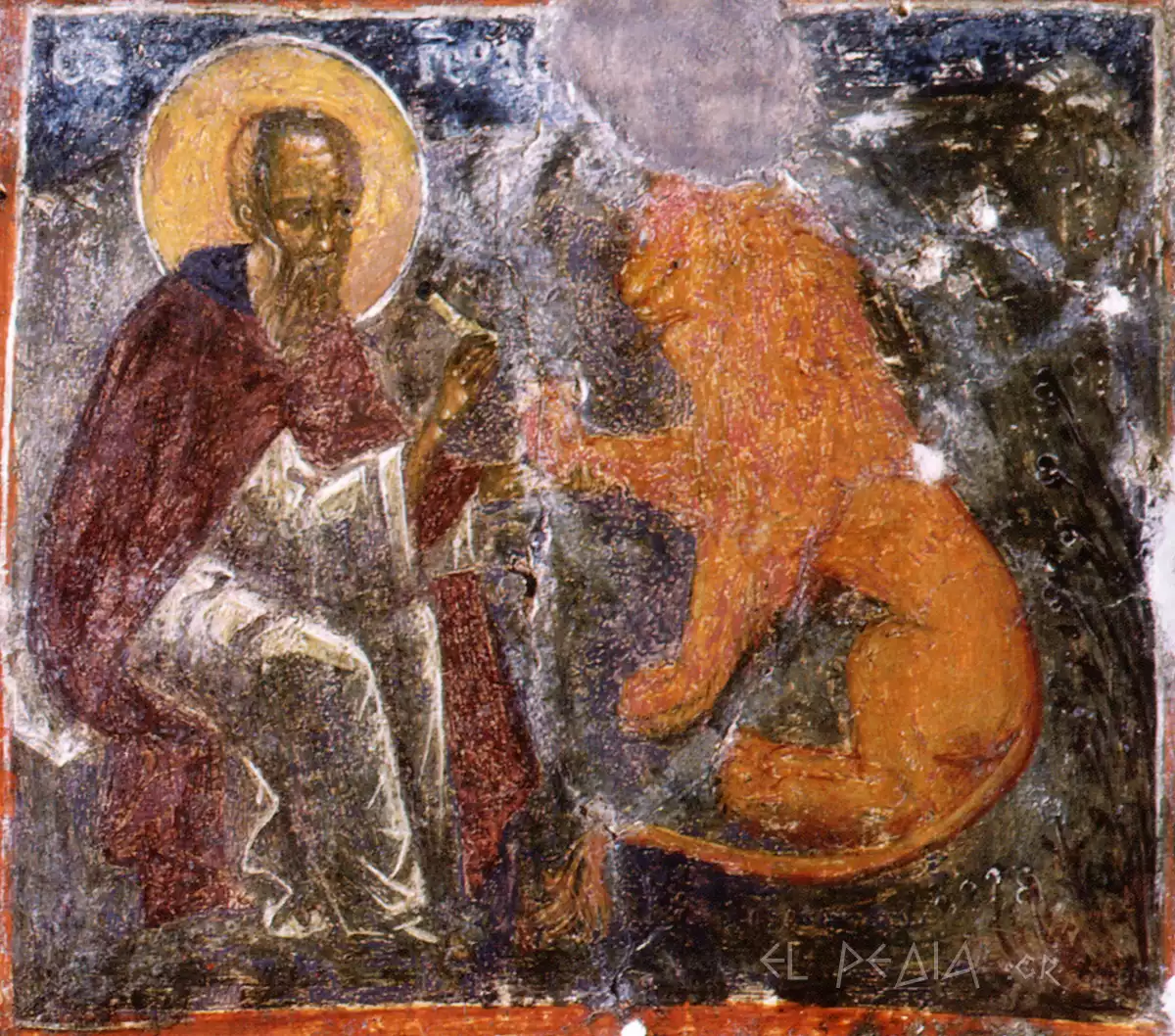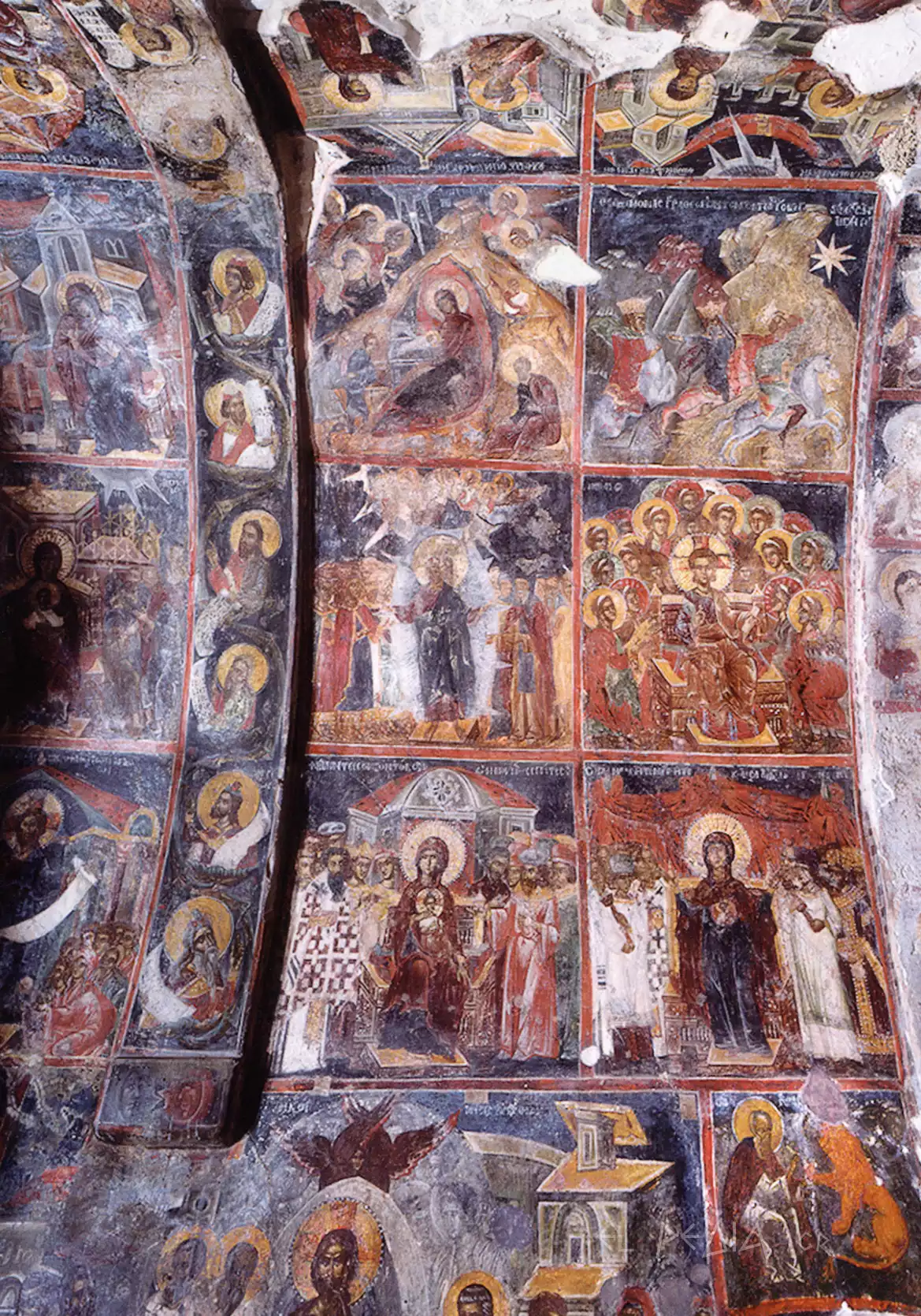
Title: Saint Gerasimos with the Lion
Artist: Unknown
Type: Fresco
Date: Early 15th century
Dimensions: Unknown
Materials: Fresco on plaster
Location: Holy Monastery of Valsamonero, Church of Panagia Odigitria, Crete
The breathtaking fresco of Saint Gerasimos with the lion, located in the church of Panagia Odigitria at the Holy Monastery of Valsamonero in Crete, is a remarkable demonstration of the artistic magic of the early 15th-century Cretan School. This work of art shows the events surrounding the death and glorious ascension of Saint Gerasimos of Jordan (c. 475 AD), depicting the famed miracle with the lion. The deep influence of Cretan Byzantine iconography in England can also be seen in the development of postmodern painting toward unnaturalism.
The anonymous iconographer’s expert technical ability comes through not only in the masterful composition of the scene but also in the almost palpable spiritual depth of the image. Here, we see St. Mark with his characteristic lion. And though the scene is filled with a commanding presence—the powerful, wild-looking lion, calm but obviously not at rest—what we have in the image is an expression of perfect peace. The lion seems to be testifying to the calm power of the holiness that has tamed him. And somehow, in the essence of presence and in the message it delivers, this fresco captures both the power of faith and the transformative nature of divine grace.
The Historical and Artistic Value of the Fresco
The fresco of Saint Gerasimos with the lion in the Holy Monastery of Valsamonero is an excellent example of post-Byzantine art from the early 15th century. The fresco is located in the northern aisle of the church, which is the oldest and is dedicated to the Virgin Mary. The composition is characterized by intense spirituality and a simple narrative structure, while its technical execution testifies to the high artistic tradition of Crete during the period of Venetian rule.
The artistic value of the work lies in the excellent depiction of the relationship between the Saint and the wild beast, as the unknown iconographer has managed to capture with particular skill both the calmness and gentleness of the Saint, as well as the submission of the lion to his holiness, creating a composition that exudes deep spirituality and symbolic content, while at the same time the iconographic art of the time highlights the uniqueness of the Cretan School (I. Karapanagiotis).
The fresco is part of the broader iconographic program of the church, which includes scenes from the life of Christ, the Virgin Mary, and various saints, creating a complete theological and artistic ensemble that reflects the spiritual quests and artistic tradition of the time. The composition, which is preserved in excellent condition, is part of a broader set of frescoes dating between 1400 and 1428, a period during which the Cretan School of iconography was at its peak.
The historical value of the fresco is enhanced by the fact that it is part of the artistic production of the Monastery of Valsamonero, an important monastic center of the early centuries of Venetian rule. The monastery, of which only the church survives today, was an important spiritual and artistic center, as evidenced by the inscriptions from the years 1332, 1404, and 1407 that have been preserved. The presence of such dated inscriptions provides valuable information for the dating and evolution of art in the region.
The technical perfection of the fresco reflects the high artistic education of the iconographers of the time and the continuity of the Byzantine tradition in Crete during the period of Venetian rule. The composition is characterized by detailed design, balanced color scale, and perfect technical execution, elements that testify to the existence of an organized artistic workshop with high expertise.
Symbolism and Theological Extensions
The southern aisle of the church, where the fresco of Saint Gerasimos with the lion is located, dates to the period 1400-1428 and is dedicated to Saint John. The iconographic composition of Saint Gerasimos is part of a broader decorative program that includes other ancient icons that require special attention and study (L. Valianou).
In the southwestern corner of the church, a smaller aisle dedicated to Saint Phanourios was formed, which was built in 1426 and is mentioned in 1431 by the Cretan painter Konstantinos Rikos. The presence of Saint Phanourios is particularly significant, as his name eventually prevailed for the monastery itself, while his memory is honored as a local saint on August 27, highlighting the importance of local worship tradition in shaping the cultural identity of the region.
The depiction of Saint Gerasimos with the lion is part of a long tradition of symbolic representations that connect holiness with the taming of wild nature, as the scene captures with exceptional skill the moment of the ascetic’s encounter with the wild beast, which submits to his spiritual power and transforms into a faithful companion, thus highlighting the possibility of spiritual transcendence of natural laws and harmonious coexistence between man and nature.
The technical restoration of the monument after 1947 by Nikolaos Platon contributed decisively to the preservation and promotion of the fresco, allowing modern generations to study and understand the deeper meaning of the composition. The conservation and protection of such works of art are essential prerequisites for preserving our cultural heritage and understanding the spiritual evolution of the place.
The iconographic tradition depicted in the fresco of Saint Gerasimos reflects the continuity of Byzantine art in Crete during the period of Venetian rule, as it combines elements of Orthodox iconography with the artistic originality of the Cretan School. The composition is a characteristic example of the ability of Cretan artists to maintain traditional iconography while simultaneously enriching their repertoire with new elements and techniques.
Stylistic Characteristics and Influences
The style of the fresco of Saint Gerasimos with the lion reveals the artist’s skill in rendering both the forms and the background. Through the simple and abstract composition, the timeless value of the Cretan School is highlighted, which managed to combine the Byzantine tradition with new artistic elements. The art of Byzantium retains its authenticity through the centuries, as evidenced by this excellent example.
The composition is characterized by an impressive balance between the natural and the transcendental element, as the unknown iconographer has managed to render with exceptional skill the harmonious coexistence of the saint with the wild beast, creating a composition that, despite its simplicity, exudes deep spirituality and symbolic content, while at the same time maintaining its artistic autonomy and aesthetic perfection.
The color scale of the fresco, with the dominance of earthy tones and the skillful use of gold in the saint’s halo, creates an atmosphere of mystery and spirituality. The color gradations and the detailed treatment of the folds in the saint’s garment testify to the artist’s skill in using the fresco technique.
The depiction of the lion, with its intense orange-red hue and dynamic stance, adds vitality to the composition and creates an interesting contrast with the serene figure of the saint. This contrast of the two figures enhances the symbolic content of the scene and underscores the transformative power of spirituality.
The influences of the Cretan School are evident in the technical execution of the fresco, as seen from the balanced composition, the careful use of colors, and the harmonious integration of the forms into the space. This style reflects the continuity of the Byzantine tradition in Crete during the period of Venetian rule and the ability of local artists to creatively assimilate different artistic influences.

The Oikoi of the Akathist Hymn in the Monastery of Valsamonero
The decoration of the arch is structured in rectangular compartments defined by red bands, creating a strict geometric grid. In each compartment, a separate scene unfolds that narrates a part of the Akathist Hymn. The color spectrum is dominated by earthy tones of brown and ochre, harmoniously combined with vivid reds and deep blues.
The composition of the scenes follows traditional Byzantine iconography, yet the rendering of the figures reveals the artistic temperament of the Cretan painter. The figures are characterized by finesse in execution and expressive power. The faces, although standardized according to Byzantine standards, retain a liveliness that betrays the artist’s skill.
The architecture of the buildings in the background of the scenes is rendered with perspective that, although simplified, creates a sense of depth. Particular interest is presented by the details in the garments of the figures and the architectural elements, which testify to the artist’s attention to the depiction of the individual elements of the composition.
The preservation of the colors, despite the wear of time, allows us to discern the original brilliance of the fresco. The decorative motifs and the halos of the saints, rendered in gold, add a spiritual dimension to the composition.
The Fresco of Saint Gerasimos with the Lion as a Timeless Symbol
The fresco of Saint Gerasimos with the lion in the Monastery of Valsamonero is a unique example of the artistic tradition of the Cretan School from the early 15th century. This composition, which masterfully combines Byzantine tradition with local elements, testifies to the high artistic level of Cretan iconographers of the time.
The timeless value of the work lies in its ability to convey timeless messages through a simple and understandable iconographic language. The harmonious coexistence of the saint with the wild beast, depicted with exceptional skill, reflects the possibility of transcending natural oppositions through spiritual cultivation.
This work is a characteristic example of the transition from classical Byzantine art to the local Cretan tradition, while maintaining elements from both artistic trends. The technical perfection of the execution, the balanced composition, and the expressive power of the forms demonstrate the maturity of the Cretan School and its ability to create works of high artistic value.
The study of the fresco reveals how Cretan artists managed to synthesize different artistic traditions, creating a unique artistic dialogue between East and West. This synthesis reflects the cultural identity of Crete during the period of Venetian rule.
Today, this fresco stands as a witness to a long-standing artistic tradition that managed to survive through the centuries, maintaining the authenticity and power of its message. It is a valuable legacy for future generations, reminding us of the importance of preserving and studying our cultural heritage.
elpedia.gr
Bibliography
e-mesara. “The Monastery of Valsamonero in 1957.” e-mesara, April 15, 2019.
e-storieskritis. “At Saint Phanourios in Valsamonero.” e-storieskritis.gr, August 27, 2017.
Karapanagiotis, I., E. Minopoulou, and L. Valianou. “Investigation of the Colourants Used in Icons of the Cretan School of Iconography.” Analytica Chimica Acta (2009).
Valianou, L., S. Wei, M.S. Mubarak, and H. Farmakalidis. “Identification of Organic Materials in Icons of the Cretan School of Iconography.” Journal of Archaeological Science (2011).

